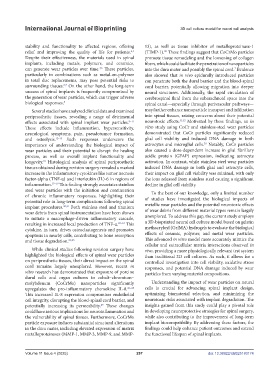Page 265 - v11i4
P. 265
International Journal of Bioprinting 3D cell culture model for neural cell analysis
stability and functionality to affected regions, offering 13), as well as tissue inhibitor of metalloproteinase-1
relief and improving the quality of life for patients. (TIMP-1). These findings suggest that CoCrMo particles
30
2,3
Despite their effectiveness, the materials used in spinal promote tissue remodeling and the loosening of collagen
implants, including metals, polymers, and ceramics, fibers, which could facilitate the penetration of nanoparticles
can generate wear particles over time. These particles, into the dura mater and possibly the spinal cord. Evidence
4,5
7
particularly in combinations such as metal-on-polymer also showed that in vivo epidurally introduced particles
in total disc replacements, may pose potential risks to can penetrate both the dural barrier and the blood-spinal
surrounding tissues. On the other hand, the long-term cord barrier, potentially allowing migration into deeper
6,7
success of spinal implants is frequently compromised by neural structures. Additionally, the rapid circulation of
the generation of wear particles, which can trigger adverse cerebrospinal fluid from the subarachnoid space into the
biological responses. spinal canal—especially through perivascular pathways—
8
Several studies have analyzed clinical data and examined may further enhance nanoparticle transport and infiltration
periprosthetic tissues, revealing a range of detrimental into spinal tissues, raising concerns about their potential
effects associated with spinal implant wear particles. 9–11 neurotoxic effects. 31,32 Motivated by these findings, an in
These effects include inflammation, hypersensitivity, vitro study using CoCr and stainless-steel wear particles
neurological symptoms, pain, pseudotumor formation, demonstrated that CoCr particles significantly reduced
and osteolysis. 12–15 Such responses underscore the glial cell viability and induced DNA damage in both
26
importance of understanding the biological impact of astrocytes and microglial cells. Notably, CoCr particles
wear particles and their potential to disrupt the healing also caused a dose-dependent increase in glial fibrillary
process, as well as overall implant functionality and acidic protein (GFAP) expression, indicating astrocyte
longevity. Histological analysis of spinal periprosthetic activation. In contrast, while stainless steel wear particles
16
tissues obtained during revision surgery revealed a marked induced DNA damage in both glial and astrocyte cells,
increase in the inflammatory cytokines like tumor necrosis their impact on glial cell viability was minimal, with only
factor-alpha (TNF-α) and interleukin (IL)-6 in regions of the ions released from stainless steel causing a significant
inflammation. 17–19 This finding strongly associates stainless decline in glial cell viability.
steel wear particles with the initiation and continuation
of chronic inflammatory responses, highlighting their To the best of our knowledge, only a limited number
potential role in long-term complications following spinal of studies have investigated the biological impacts of
implant procedures. 20,21 Both stainless steel and titanium metallic wear particles and the potential neurotoxic effects
wear debris from spinal instrumentation have been shown of wear debris from different material types remain largely
to initiate a macrophage-driven inflammatory cascade, unexplored. To address this gap, the current study employs
resulting in increased local production of TNF-α. 22–24 This a 3D-bioprinted neural cell culture model based on gelatin
cytokine, in turn, drives osteoclastogenesis and promotes methacryloyl (GelMA) hydrogels to evaluate the biological
apoptosis in nearby cells, contributing to bone resorption effects of ceramic, polymer, and metal wear particles.
and tissue degradation. 21,25 This advanced in vitro model more accurately mimics the
cellular and extracellular matrix interactions observed in
While clinical studies following revision surgery have vivo, providing a more physiologically relevant test system
highlighted the biological effects of spinal wear particles than traditional 2D cell cultures. As such, it allows for a
on periprosthetic tissues, their direct impact on the spinal controlled investigation into cell viability, oxidative stress
cord remains largely unexplored. However, recent in responses, and potential DNA damage induced by wear
vitro research has demonstrated that exposure of porcine particles from varying material compositions.
dural cells and organ cultures to cobalt–chromium–
molybdenum (CoCrMo) nanoparticles significantly Understanding the impact of wear particles on neural
upregulates the pro-inflammatory chemokine IL-8. 26–28 cells is crucial for advancing spinal implant design,
This increased IL-8 expression compromises endothelial optimizing biomaterial selection, and minimizing the
cell integrity, disrupting the blood-spinal cord barrier, and neurotoxic risks associated with implant degradation. The
potentially increasing its permeability. These changes insights gained from this study could play a pivotal role
29
could have serious implications for neuroinflammation and in developing neuroprotective strategies for spinal surgery,
the vulnerability of spinal tissues. Furthermore, CoCrMo while also contributing to the improvement of long-term
particle exposure induces substantial structural alterations implant biocompatibility. By addressing these factors, the
in the dura mater, including elevated expression of matrix findings could help enhance patient outcomes and extend
metalloproteinases (MMP-1, MMP-3, MMP-9, and MMP- the functional lifespan of spinal implants.
Volume 11 Issue 4 (2025) 257 doi: 10.36922/IJB025180174

